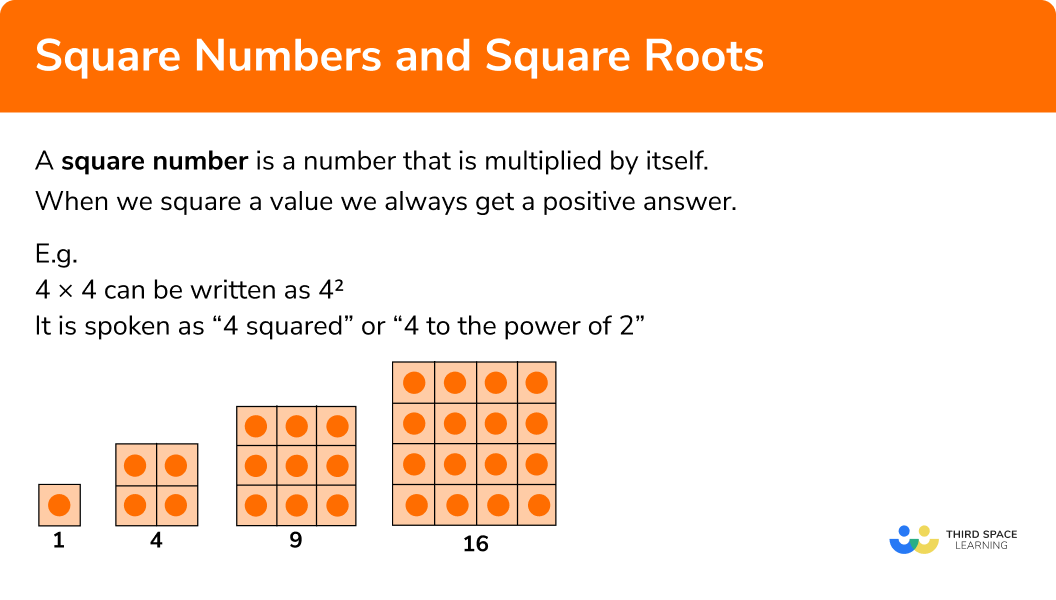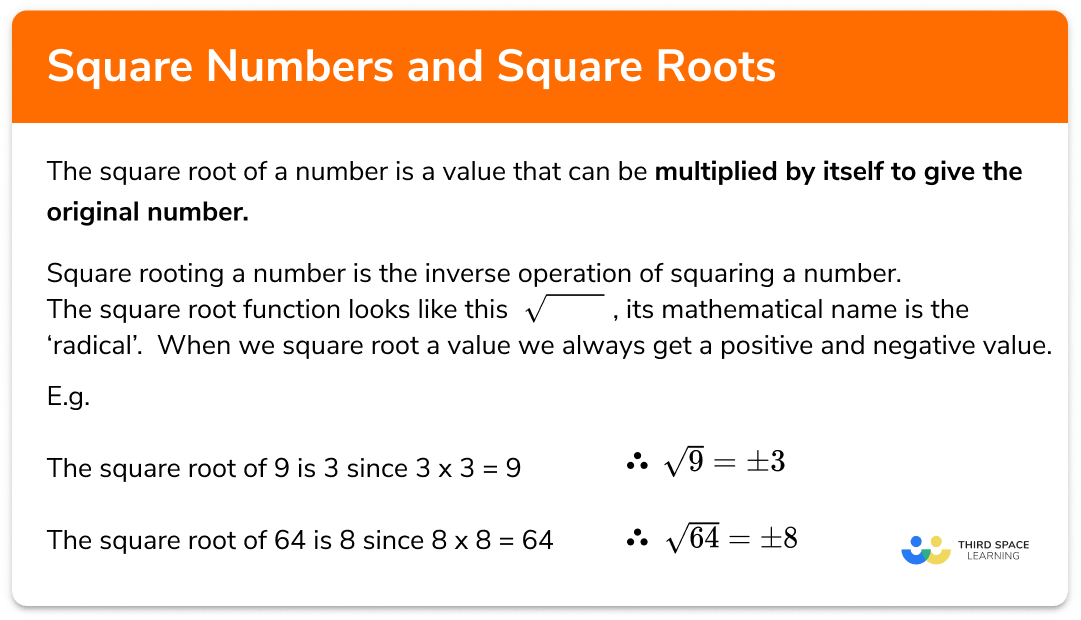One to one maths interventions built for KS4 success
Weekly online one to one GCSE maths revision lessons now available
This topic is relevant for:

Squares And Square Roots
Here we will learn about squares and square roots including what a square number is and what a square root is, as well as how to square a number and how to find square root of an integer. You’ll also learn how to solve problems by applying knowledge of squares.
There are also squares and square roots worksheets based on Edexcel, AQA and OCR exam questions, along with further guidance on where to go next if you’re still stuck
What is a square number?
Squares, or square numbers, are found when we multiply an integer (whole number) by itself.
E.g.
4 × 4 can be written as
For GCSE Mathematics you need to know squares up to
A square number can be represented as an array which forms the shape of a square.
E.g.
We can arrange
We can arrange
We can arrange
We can arrange
E.t.c
What is a square number?

Perfect squares
The square number of an integer is also called a perfect square.
We can square numbers with decimal places but we do not refer to these as square numbers or perfect squares.
A given number or variable that is ‘squared’ is multiplied by itself and this applies to decimals as to integers.
Squaring negative numbers
We can also square negative numbers.
E.g.
When we square a negative number we get a positive number.
This is because a negative number multiplied by a negative number gives us a positive result.
Learn more by reviewing our lesson on negative numbers.
When we square negative
This is true for all numbers (and variables)
E.g.
What is a square root?
The square root of a number is a value that can be multiplied by itself to give the original number. For example the square root of 225 is 15
A square root is the inverse operation of squaring a number.
The square root symbol looks like this:
Its mathematical name is the ‘radical’. The square root function only gives us the positive value of the square root. We call this the principal square root.
When we square a positive number/variable or a negative number/variable we always get a positive answer.
This means when we want the square root a number/variable we get a positive and a negative answer.
The symbol
E.g.
In GCSE mathematics, if asked to find the square root of a number you would only need to give the positive value of a square root which is the principal square root.
What is a square root?


Square numbers worksheet

Get your free square numbers worksheet of 20+ questions and answers. Includes reasoning and applied questions.
DOWNLOAD FREE
Square numbers worksheet

Get your free square numbers worksheet of 20+ questions and answers. Includes reasoning and applied questions.
DOWNLOAD FREERelated lessons on powers and roots
Squares and square roots is part of our series of lessons to support revision on powers and roots. You may find it helpful to start with the main powers and roots lesson for a summary of what to expect, or use the step by step guides below for further detail on individual topics. Other lessons in this series include:
Key words
Term
A single number (constant) or variable.
E.g.
In the expression
Coefficients
The number which the variable is being multiplied by.
E.g.
In
Integer
A whole number.
E.g.
Index (also called exponent or powers)
The index number is the number of times you multiply a number/variable by itself.
E.g.
The index number in
Note: the plural of index is indices.
Note: you will see index number as a superscript.
Base number
The number/variable that is being multiplied by itself an amount of times.
E.g.
The base number in
Advanced vocabulary – only for Additional Maths, A-Level
Real numbers
Any positive or negative number is called a real number. Numbers that are not ‘real’ are called imaginary numbers. Integers, decimals, fractions are all examples of real numbers.
E.g.
Imaginary numbers
Numbers that are not real are called imaginary numbers, for example you will notice we cannot find a real square root of a negative number (try it on a calculator), this because it is an imaginary number. Numbers that contain an imaginary part and real part are called complex numbers.
Squares and square root examples
Example 1
What is
So,
Example 2
What is
So,
Example 3
What is the positive square root of
The square root of 64 means what value can be multiplied by itself to give
The question only needs the positive answer.
So,
How to use squares and square roots
In order to solve problems involving square numbers and square roots :
- Identify whether you need to square or square root the number/variable
- Perform the operation
- Clearly state the answer within the context of the question e.g. including units, only the positive value
Squares and square root problems examples
Example 4: knowledge of squares
Martin says
- Identify whether you need to square or square root the number/variable
The question focus is on squaring
2 Perform the operation
3 Clearly state the answer within the context of the question
Martin is wrong because
The mistake Martin made was he did
Example 5: problem solving with square roots
Daphne says the square root of a number is always smaller than the original number.
Prove Daphne is incorrect.
Identify whether you need to square or square root the number/variable
You are looking for a relationship between the square root of a number and the original number. It doesn’t have to be an integer, it could be a fraction or decimal. You could try finding the square root of
Perform the operation
Clearly state the answer within the context of the question
Daphne is incorrect because:
Therefore the positive square root of
Example 6: solving problems involving square numbers
The sum of two square numbers is
Identify whether you need to square or square root the number/variable
Remember sum means add.
Therefore you are looking for two square numbers that add together to make
It will help here to list the square numbers up to
Perform the operation
You now need to pick two of these numbers that when added together make
Clearly state the answer within the context of the question
The two square numbers are
Example 7: square numbers within a 2D polygon
A square has an area of
Identify whether you need to square or square root the number/variable
The area of a square is found by multiplying the length and width together.
For a square the length and width are the same length.
Therefore you are looking for a number that when multiplied by itself (or squared) is equal to
Therefore you need to find the square root of
Perform the operation
Clearly state the answer within the context of the question
The length of a side cannot be negative therefore the answer is
You must include the units so the final answer is
Example 8: square numbers within a 2D polygon
The length of one side of a square is
Identify whether you need to square or square root the number/variable
The area of a square is found by multiplying the length and width together. For a square the length and width are the same length.
Therefore we are going to multiply
Perform the operation
Clearly state the answer within the context of the question
You must include the units so the final answer is
Example 9
Rebecca says “when you add three consecutive square numbers, the answer is always odd”.
Is Rebecca right? Explain your answer.
Identify whether you need to square or square root the number/variable
To prove Rebecca wrong we only need to find one example where she is incorrect, this is sometimes known as proof by contradiction.
Therefore we are looking for
It will be helpful here to list the ‘main’ square numbers.
Perform the operation
The square numbers:
You are now looking for one example where three of these numbers when added together make an odd number.
For example:
Clearly state the answer within the context of the question
Rebecca is wrong because
Common misconceptions
- Square numbers
Incorrect understanding of squaring a number.
E.g.
Not knowing the square numbers up to and including
- Square roots
Only recognising positive values of square roots of integers.
E.g. When solving an equation of the form x^{2} = 100 You need to find the postive and negative square roots of 100.
x=\pm \sqrt{100} = \pm10 not 10
Practice square numbers and square roots questions
1. What is 4 squared?




4 squared =4 multiplied by 4 = 16
2. What is the positive square root of 100?




10 \times 10 = 100 therefore \sqrt{100}=10
3. What is 7^2?




7^{2}=7 × 7=49
4. What is x if x^{2} = 144 ?
12 and -12

12 and

11 and 12

11 and -11

12 × 12=144 and -12 × -12=144
5. The sum of two square numbers is 29 . Find the two square numbers.
1 and 24

4 and 25

4 and 16

9 and 16

The square numbers up to 29 are 1, 4, 9, 16 and 25.
The two square numbers that add up to 29 are 4 and 25.
6. A square has an area of 225 cm^2. What is the length of one side?
22.5cm

112.5cm

56.2cm

15cm

To find the area of a square, we multiply the side lengths together.
Since the height and width of a square are equal, we need to find a number which, when multiplied by itself, makes 225 . Therefore we need to find the positive square root of 225.
\sqrt{225}=15
Square numbers and square roots GCSE questions
1. Work out the value of:
(a) 3^{2}
(b) 3 \times 2^{2}
(c) 6^{2} \times 2^{2}
(3 Marks)
(a) 3 \times 3
9
(1)
(b) 3 \times 4
12
(1)
(c) 36 \times 4
144
(1)
3. Find the value of:
(a) \sqrt{25}
(b) \sqrt{144}
(c) \sqrt{400}
(3 Marks)
(a) 5
(1)
(b) 12
(1)
(c) 20
(1)
4. Simplify the following expression:
4^{2} \times \sqrt{x^{2}}
(2 Marks)
Correct coefficient
(1)
Correct x (or x^{1} )
(1)
Learning checklist
You have now learned how to:
- Calculate square numbers up to 15 × 15
- Use positive integer powers and their associated real roots
- Recognise and use the square numbers
- Apply properties of squares to a context
Still stuck?
Prepare your KS4 students for maths GCSEs success with Third Space Learning. Weekly online one to one GCSE maths revision lessons delivered by expert maths tutors.

Find out more about our GCSE maths tuition programme.